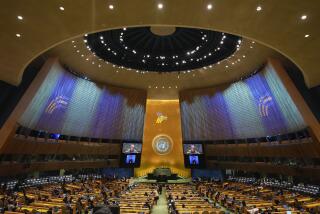125 Countries Line Up to Sign Land-Mine Ban
- Share via
OTTAWA — In a ceremony that was part celebration and part strategy session for the future, representatives of 125 nations converged on the Canadian capital Wednesday to sign a treaty pledging to eliminate their land mines, the indiscriminate weapons blamed for killing or injuring an estimated 25,000 people, mainly civilians, each year.
While the agreement falls short of a global ban--a number of major military powers, including the United States, have declined to participate--it will, if enforced, rid continents of antipersonnel mines and put the weapons in the same outlaw category as poison gas in much of the world.
Officials said the accord will have the greatest effect in poor countries, where the daily trip to a village well can become a deadly obstacle course across a field sown with hidden mines.
“We have gathered today in a spirit of celebration, at a time of hope, to mark a historic victory for the weak and the vulnerable of our world,” United Nations Secretary-General Kofi Annan said Wednesday. “It is they who have paid the ultimate price in lives and limbs. It is they and their children who will reap the reward of security and civility that this ban makes possible.”
He also noted that the treaty process, spearheaded by the Canadian government, marked the emergence of a new brand of diplomacy.
Backers of the treaty developed the accord without initial support from the U.S. or other world powers. Their methods included bypassing the usual international negotiating forums; using as their most visible spokesman not a political leader but Britain’s late Princess Diana; and drawing inspiration and momentum from an alliance of humanitarian, medical, veterans, religious and peace groups.
The alliance, known as the International Campaign to Ban Landmines, and its chief coordinator, Jody Williams of Vermont, won the Nobel Peace Prize this year for the effort.
“Your success is a welcome reminder that one does not have to be a global superpower to affect the future of international peace and security,” Annan said in his speech just before Canada became the first signer of the pact.
The treaty, negotiated in Oslo in September, bans the production, storage, transfer and use of antipersonnel land mines. It will take effect once ratified by the parliaments of 40 signatory countries, a process Canadian Foreign Minister Lloyd Axworthy estimated will take 12 to 14 months. Once it is in force, parties to the treaty have four years to destroy their stockpiles of mines and 10 years to remove mines planted within their borders.
There is no precise estimate of the number of mines lurking unexploded underground, some of which date from World War II. But the U.N. places the number at more than 100 million. Because mines remain deadly for years, most casualties are civilians, particularly in underdeveloped countries of Africa and Asia. Mines also keep farmland out of production, block roads and airports and drive up medical costs in poor nations.
In a speech Wednesday, Williams noted that the drive for the treaty began in 1992 with humanitarian groups who were “trying to put limbs back on victims” in Southeast Asia. They realized that the only long-term solution was to get rid of the cause of the injuries. That led them to “push, holler and shove” governments into action, she added.
At an Ottawa conference on mines in October 1996, Axworthy challenged countries to return in 14 months to sign a completed treaty. He and others on Wednesday expressed surprise at their success; Williams said that, at the time of Axworthy’s challenge, she expected no more than 36 countries to agree to a ban.
The 125 nations expected to sign the treaty by the conference’s close today include most countries in Africa, the Americas and Europe and all but two North Atlantic Treaty Organization members. Those refusing to sign, besides the U.S., include Russia, China, India, Pakistan, Turkey, Finland and almost every country in the Middle East.
Participants in the three-day conference here devoted considerable time to strategizing on how to persuade more nations to join the treaty and on the difficult question of how to enforce a ban on a weapon that is among the cheapest to make, easiest to hide and often is used by rebel groups that don’t fall under treaty jurisdiction.
Although the agreement includes a mechanism for investigating countries suspected of violations, experts here say the best hope for enforcement will be stigmatizing and ostracizing nations that continue to use mines.
The Clinton administration rejected the treaty because it does not exempt the Korean peninsula--where mines remain a key part of the Pentagon’s defense strategy--and a U.S. antitank weapon that includes antipersonnel mines. But the U.S. already bans export of mines, and Clinton has pledged to try to eliminate all U.S. mine use outside Korea by 2003 and to develop alternatives to mines in Korea by 2006.
The United States also has promised to spend $80 million for mine clearance around the world in the current fiscal year and hopes to raise that amount to $100 million next year. The U.S. has suggested a worldwide campaign to raise $1 billion a year from government and private sources to clear mines from populated areas by 2010.
Canadian Prime Minister Jean Chretien announced Wednesday that Canada will allocate $73 million in the next five years to implement the treaty; Norway has pledged $120 million over the same period. Other countries are expected to make similar promises.
Karl F. Inderfurth, the assistant U.S. secretary of State who is heading the American mine-removal initiative, led the U.S. delegation here and found himself defending the administration’s decision not to sign the treaty.
The toughest criticism of the administration came from Americans at the conference, including Sen. Patrick J. Leahy (D-Vt.) and Reps. Jack Quinn (R-N.Y.) and Lane Evans (D-Ill.), who have sponsored legislation to force the U.S. to give up its mines.
“By not signing, we weaken the treaty; we give others an excuse not to sign, and thereby we become part of the problem,” Leahy said in a speech here Tuesday.
Williams also accused the U.S. of being out of step with history. “Here we have 125 governments recognizing that the tide of history has changed, recognizing that together we are a superpower,” she said. “It’s a new definition of superpower. It is not one, it is everybody.”
Indeed, the unorthodox origin of the mine treaty has led to speculation here about other prospects for alliance between civic groups and middle-power governments. Axworthy, for example, mused about the possibility of a treaty regulating international trafficking in small arms.
Others here, however, said that, while the potential of such a coalition is tantalizing, there is no other issue on the horizon that could command the kind of broad and emotional support that came to be associated with the anti-land-mine campaign.
More to Read
Sign up for Essential California
The most important California stories and recommendations in your inbox every morning.
You may occasionally receive promotional content from the Los Angeles Times.










